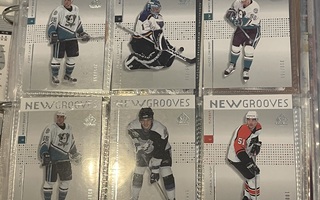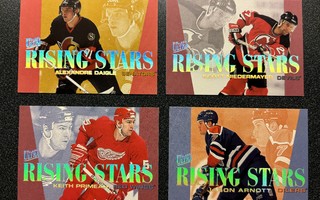Film Noir Classic Collection, Vol. 4 R1 boksi
Kuvaus
Film Noir Classic Collection, Vol. 4 (Act of Violence / Mystery Street / Crime Wave / Decoy / Illegal / The Big Steal / They Live By Night / Side Street / Where Danger Lives / Tension)
R1 jenkki aluekoodin julkaisu (tarvitset siis R1 tai aluekoodittoman soittimen). Ei suomitekstejä, tekstit englanniksi. HUOM! KTS kysymykset, en ole vielä kerinnyt varmistamaan näiden toimivuutta.
Hieno boksi klassisia Film Noir elokuvia.
Film Noir Classics Collection, The: Volume 4 (DVD)
Ex-World War II pilot Frank Enley (Van Heflin) is a respected contractor and family man. Then his troubled, gimp-legged bombardier (Robert Ryan) shows up with a gun and a score to settle. Perhaps neither man is what he seems to be as director Fred Zinnemann (The Day of the Jackal) guides a searing Act of Violence, "the first postwar noir to take a challenging look at the ethics of men in combat" (Eddie Muller, Dark City: The Lost World of Film Noir). Murder lives on Mystery Street. John Sturges (The Great Escape) directs a revealing-for-the-era procedural about a Boston cop (Ricardo Montalban) solving a whodunit with the help of a Harvard forsensic expert (Bruce Bennett). Welcome to CSI Noir.
]]>
Amazon.com
The fourth volume of Warner Video's Film Noir Classic Collection boasts ten titles on five double-feature discs--appropriate packaging for films that mostly run less than an hour-and-a-half and would have shared the marquee with another picture upon original release. It's a welcome set, with entries by top noir directors Anthony Mann and Nicholas Ray, several unheralded gems, and solid entertainment value in nearly every instance. But somebody (and it looks as if that's us) ought to mention that Warners is getting a mite cavalier with the label "film noir." You can have a '40s or '50s movie that's in black and white, involves criminal activity, and features stars like Robert Mitchum or Edward G. Robinson, and still not tap into the pungent atmosphere, perverse psychology, implacable fatalism, and jagged/voluptuous style that are the hallmarks of noir. Indeed, there are several such movies in this set--and in their non-noir ways, they're not bad.
Act of Violence (1948) is the real McCoy, albeit so meticulously directed by Fred Zinnemann in postwar-European style that it's virtually an art-film noir. Van Heflin plays a model small-town citizen suddenly confronted with a guilty WWII past, in the dark, limping, permanently trenchcoated figure of Robert Ryan. The film systematically dismantles the domestic security of Heflin's life till he's forced to flee his own home, which has become a trap, and escape into the nightworld of the big city. Mary Astor is superb as one of its few sympathetic denizens. Co-featured with Act of Violence is Mystery Street (1950), a hard-edged movie about a B-girl's murder and some of the proto-CSI techniques the police use to solve the crime. Directed by John Sturges, from a script by Richard Brooks and Sydney Boehm, the picture is enhanced by atmospheric Boston and Cape Cod settings and camerawork by Mr. Film Noir himself, John Alton.
For case-hardened noiristes, the disc holding Decoy and Crime Wave is the collection's prime catch. Decoy (1946), like Dillinger in Volume 2, is an ultra-low-budget offering from Monogram Pictures and a fascinatingly mixed bag of Poverty Row production values and flashes of directorial ambition (one night scene in a woods strongly suggests director Jack Bernhard had seen Sunrise). Its main attraction is a cold-hearted heroine who could pledge the same sorority as the dames from Double Indemnity, Gun Crazy, and The Lady from Shanghai. (Alas, British-born actress Jean Gillie appeared in only one subsequent film, dying at the age of 34.) Andre De Toth's Crime Wave (1954) places us in the awkward position of being grateful for the chance to see an exciting movie and obliged to disqualify it from the set: it's closer to the '50s police procedural (Dragnet et al.) than to film noir. Shot almost entirely on location, the picture virtually reeks of seedy L.A. nightlife and satisfyingly unreels without benefit of music score. Ted De Corsia, Nedrick Young, and Charles Buchinsky-soon-to-be-Bronson supply juicy villainy, with a characteristically unclean contribution late in the film from Timothy Carey. Gene Nelson plays an ex-con, resolved to go straight yet being forced to abet his newly escaped old cellmates, and the world-weary cop keeping tabs on all of them is Sterling Hayden.
The set's two stellar noir directors share a disc and costars, Farley Granger and the ethereal Cathy O'Donnell. They Live by Night (1948) was Nicholas Ray's maiden effort, and kinetically and emotionally the director found natural rapport with the spooked-animal vulnerability of his hero and heroine. This was the first film version of Edward Anderson's Depression-era novel Thieves Like Us (adapted again a quarter-century later by Robert Altman), and its tale of a young rural misfit drawn into more violent crime by older, harder fellow escapees from a prison farm anticipates the spirit of Ray's '50s teen classic Rebel Without a Cause. Side Street (1949) is fascinating as a bridge between Anthony Mann's great series of noirs shot by John Alton and the Western genre Mann would soon master. Working this time with a conventional MGM cameraman (Joseph Ruttenberg), the director demonstrates that the terrific "eye" that gave us T-Men, Border Incident, et al. was at least as much Mann's as Alton's, and he visualizes Manhattan as a collection of jagged skylines and deep, shadowed canyons. The script (by Sydney Boehm) involves a mail carrier (Granger) who, worried about taking proper care of his pregnant wife (O'Donnell), impulsively swipes an envelope full of money. Hard upon that "one false step," the family man finds himself caught up in a dark scheme involving blackmail and, several times over, murder.
Despite a screenplay by Hitchcock collaborator Charles Bennett and direction by John Farrow (The Big Clock), Where Danger Lives (1950) is easily the weakest entry in Vol. 4. Robert Mitchum plays a doctor who saves a would-be suicide, then falls for her without noticing she's crazy as a loon, and homicidal to boot. Soon they're on the run, sought by the law and at the mercy of every larcenous character between them and the Mexican border. Despite yeoman work by Mitchum and RKO shadowmaster Nicholas Musuraca, and the too-brief participation of Claude Rains, the film founders on the femme-fatale casting of Howard Hughes discovery Faith Domergue. A more memorably dodgy female complicates everybody's life in Tension (1950), the next-to-last Hollywood film for director John Berry before his blacklisting. This one's played by Audrey Totter--never a major star, but a delicious and definitive late-'40s dame (who also supplies sharp commentary on the auxiliary audio track). Her milquetoast husband, pharmacist Richard Basehart, sets up a second identity for himself under which to seek revenge for her numerous infidelities--till the new man he has become makes the acquaintance of neighbor Cyd Charisse. (No, Charisse does not dance, but those awesome legs are nevertheless put to creative use.) Eventually someone is dead, and cops Barry Sullivan and William Conrad enter the picture, contributing their own shades of gray to the noir palette. Another satisfying, little-known film that collections like this one lead us to discover.
There's also satisfaction to be had from our final pairing, Illegal and The Big Steal--even if both these titles have to be turned back at the noir border. Illegal (1955) is the third version of The Mouthpiece, a '30s play and film about an esteemed district attorney who falls from grace but rebounds as a spellbinding defense attorney much-sought-after by the criminal class. It was probably the best part Edward G. Robinson had in the '50s, and he's all the reason we need for watching. But the role and the story predated noir (the previous renditions came out in 1932 and 1940), and this movie, for all intents and purposes, postdates noir. In addition, sad to say, it's an artifact from that era when Warner Bros.' movies had started looking like the studio's TV shows. By contrast, The Big Steal (1949) springs from the heart of the classic noir era, was produced for perhaps the most noir-friendly of studios, RKO, and even boasts the costars and screenwriter of the sublime Out of the Past--which is to say, Robert Mitchum, Jane Greer, and Daniel Mainwaring (a.k.a. "Geoffrey Homes"). The whirlwind first reel plops us right in the middle of several chases, with as many switcheroos of allegiance and direction, in pursuit of an "it" that won't be specified till some time later. All nimbly managed by director Don Siegel, on location in Mexico yet, and briskly over with in 72 minutes. But it's a comedy-adventure, not a film noir. Not even close.
Most of the films come accompanied by authoritative voiceover commentaries, including contributions by L.A. crime novelist James Ellroy (on Crime Wave) and surviving cast members Nina Foch (Illegal) and Audrey Totter (Tension). However, for a sporadic series of primers on noir style, which feature absurdly florid lighting of the talking heads and lesson-plan intertitles that belong on a blackboard, somebody at Warner Home Video should be taken for a ride. --Richard T. Jameson
Levyt ja kotelot hyväkuntoiset, lähes kuin uudet. Ostaja maksaa postituskulut 8 euroa.
Jos ostat enemmän elokuvia, 9 euron postikuluilla saat niin monta elokuvaa kuin jaksat ostaa!
Myyjä
Osta heti
Lisätiedot
Maksaminen ja toimitus
Hintaehdotukset
Kysymykset
Kirjaudu sisään tai luo uusi tunnus.
Kiitos vastauksesta.Oman boksin elokuvista jumittavat ainakin Mystery street,Crime Wave (lopussa) ja Side Street.Voisin ostaa toisen boksin kun tietäisin toimivatko nämä.
Moi,
Oletko testannut toimivatko elokuvat?Valitettavasti tämä on yksi näistä jenkkilän Warnerin ongelmajulkaisuista jossa levyt skippaavat/pätkivät tai jumittuvat paikoilleeen.
Moi. Kiitos tiedosta, en ollutkaan kuullut tuosta. Olen katsonut näistä vain pari, joten pitäisi siis testata loputkin. Laitan tänne tietoa kun teen tuon, voi kestää pitkäänkin. Laitan huomion ilmoitukseen.

